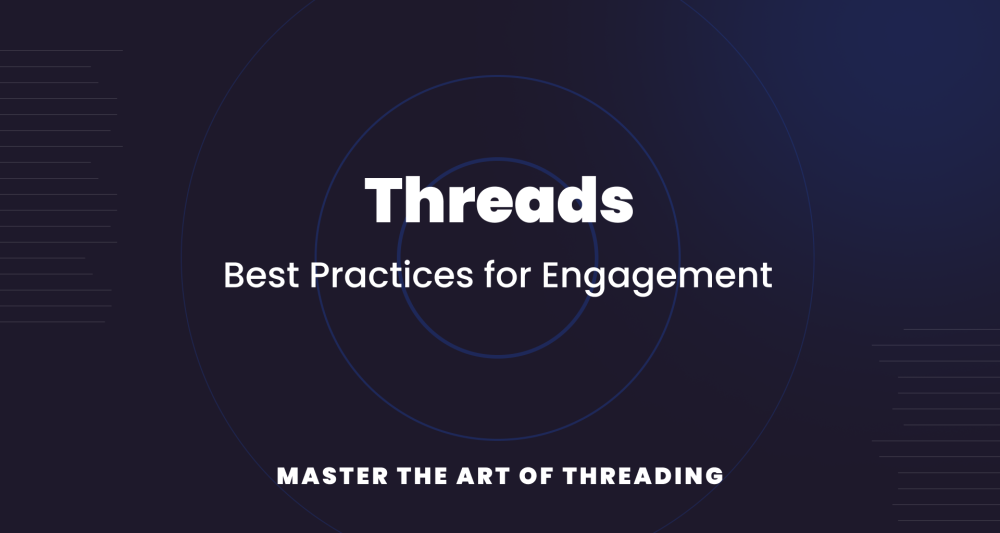Threads on X: Best Practices for Engagement Written on . Posted in Best practices.

Threads on X (formerly Twitter) have become a powerful tool for storytelling, thought leadership, and sharing detailed information that can’t fit in just 280 characters. Whether you’re breaking down complex topics, sharing personal experiences, or dropping a how-to guide, mastering the art of writing threads is key to standing out and driving engagement on X.
Threads' affiliation with Meta has afforded them certain advantages, such as an ad-free experience in its early days and cross-platform functionalities that leverage existing users from platforms like Instagram.
This article dives into why threads work, how to write engaging threads, and best practices to maximize their impact.
Understanding Threads
Threads are a series of connected posts that allow users to share more information, tell a longer story, or develop an argument over multiple points. Each post in a thread is linked to the previous and next post, creating a continuous, cohesive narrative. Unlike regular posts, which are constrained by a character limit, threads offer a way to break down longer content into easy-to-digest chunks. This format is particularly popular among marketers because it allows for detailed storytelling and in-depth discussions, making it easier to engage users and convey complex ideas effectively.
Why Threads Are So Effective on X
A well-crafted thread allows users to keep their audience hooked while delivering a cohesive message over multiple tweets. Some key reasons why threads work:
-
Algorithm favorability: Longer interactions (like reading through a thread) signal value to the X algorithm, boosting visibility.
-
Storytelling power: Threads let you tell a story with a beginning, middle, and end—capturing emotions and driving engagement.
-
Deeper conversations: Instead of truncating ideas, threads allow for detailed thoughts and analyses, encouraging replies and retweets.
-
Bookmark potential: Users love bookmarking valuable threads to revisit later, helping your content live longer.
Additionally, the gradual rollout of features over the past year has enhanced thread functionality, making them even more effective.

Want more insights into AI’s impact on social media? Check out How AI Is Shaping Social Media Content.
How to Write Engaging Threads on X
Follow these actionable tips to create compelling threads that capture attention and keep your followers engaged:
1. Hook Them with the First Tweet
Your first tweet is like a headline—if it’s weak, your audience won’t bother reading the rest. Craft a compelling opener that triggers curiosity or emotion.
-
Use a bold statement:“Here’s how I grew my side hustle from $500 to $50K in 6 months—without paid ads.”
-
Start with a question:“Ever wonder why some people thrive on X while others struggle?”
-
Use FOMO (Fear of Missing Out):“If you’re not using this AI tool yet, you’re already falling behind.”
-
Leverage favorite tweets:“Remember this viral tweet? Here’s why it’s still relevant today.”
Discover more about crafting strong hooks in our detailed article How to Capture Attention with Hooks on X.
2. Plan Your Structure Before Writing
Think of your thread as a mini-blog post. Organize your thoughts logically, keeping each tweet short and focused. Plan out:
-
A clear introduction (what readers should expect)
-
A logical sequence of tweets building on each other
-
A strong ending or call-to-action (more on this below)
3. Use a Conversational Tone
People come to X for conversations, not formal essays. Keep your writing friendly and approachable. Use contractions, rhetorical questions, or even emojis—if that suits your style.
“So, what’s the secret sauce? Let me break it down for you👇” Threads can also help you stay updated with your friends across different platforms.
4. Incorporate Visuals for Impact
Adding relevant images, GIFs, videos, or screenshots can make your thread more engaging and memorable. Visual content breaks up text and adds context.
For example:
-
Infographics or graphs to illustrate data points
-
Screenshots of tools, articles, or tweets that support your point
-
GIFs to convey emotions or humor
Learn how visuals can enhance your engagement in our article on Creating Viral Content on X.
5. Use Numbers and Lists to Structure Tweets
Readers love scannable content, and numbers make your points clearer. Structure some tweets with lists or step-by-step breakdowns.
“Here are 3 tools every X user should try:
-
Canva – for visuals
-
Supapost – for post generation
-
Typefully – for thread drafting”
We welcome your suggestions on how to improve the structure of our threads.
Best Practices for Writing Threads on X
1. Include a CTA in Your Final Tweet
Encourage readers to engage with your content by adding a clear call-to-action (CTA) in the last tweet. Ask them to retweet, reply, or follow for more content.
Example:
"Found this helpful? Retweet so others can benefit too! And follow for more insights like this 👇"
This small nudge can increase your thread’s visibility exponentially.
2. Tweet Frequently to Boost Visibility
Stay active and reply to comments within your own thread to keep the conversation going. The more interaction your thread receives, the higher it will rank in the X feed.
For more insights into optimal timing, check out What Is the Best Time to Post on X.
3. Use Relevant Hashtags (But Don’t Overdo It)
Threads tend to perform well organically, but a few strategic hashtags can increase their discoverability. Stick to 1-2 hashtags relevant to your topic.
Example:
"The future of AI is here—#AI #Technology"
Learn how to master hashtags with our Step-by-Step Guide to Hashtags on X.
4. Tease or Quote-Retweet Your Own Threads Later
Sometimes, people miss your thread when you first post it. A great strategy is to tease your thread in a new tweet or quote-retweet it to reignite interest.
Example: “In case you missed it: My complete guide to building a successful X profile—👇”
Check out our guide to Building a Personal Brand on X for more tips. Additionally, you can use a thread reader bot by replying to your tweet with a specific keyword to unroll and make your threads more accessible and easier to navigate.
Measuring Thread Performance
Understanding how your threads perform is crucial for refining your strategy and maximizing impact. Key metrics to track include engagement, reach, and clicks. Engagement metrics, such as likes, comments, and shares, reveal how well your thread resonates with users. Reach metrics, including impressions and views, show how many users are seeing your thread. Click metrics, like link clicks and website traffic, indicate how many users are taking action based on your content. By monitoring these metrics, you can gain insights into what works and what doesn’t, allowing you to fine-tune your approach for better results.
Advanced Thread Features
To make your threads even more engaging, take advantage of advanced features. Adding videos can break up the text and make your thread more dynamic, capturing users’ attention. Including links can drive traffic to your website or landing page, providing additional value to your audience. Threads can also foster a sense of community by inviting users to share their thoughts or opinions. Additionally, creating a sense of urgency with time-sensitive language or promotions can prompt immediate action. These features not only enhance the user experience but also increase the effectiveness of your threads.
Common Thread Mistakes
Creating effective threads involves avoiding some common pitfalls. One mistake is making the thread too long or too short. Overly long threads can overwhelm readers, while too-short threads may not provide enough value. Another common error is failing to optimize for mobile devices. Since many users access social media platforms on their phones, it’s essential to ensure your thread is easy to read and navigate on smaller screens. Additionally, threads should be visually appealing, incorporating images or videos to break up the text. Finally, make your threads engaging by including questions or prompts to encourage user participation. By steering clear of these mistakes, you can create threads that are both impactful and user-friendly.
Examples of High-Impact Threads
-
Educational Threads
Share industry insights or tutorials.
Example: “How I automated 80% of my workflow with these 5 tools 🚀” -
Storytelling Threads
Narrate personal experiences or business journeys.
Example: “Let me tell you how a single tweet changed my career forever…” -
Community Threads
Encourage engagement by posing a question or running a poll.
Example: “What’s the best piece of career advice you’ve ever received? Share below 👇” -
List Threads
Break down resources, books, or tools.
Example: “10 must-read books for aspiring entrepreneurs 📚”
For even more ideas on high-impact threads, see our post on Threads on X: Best Practices for Engagement.
Start Threading for Impact
Threads are a fantastic way to break free from the 280-character limit and deliver meaningful value to your audience. By using hooks, conversational language, visuals, and clear CTAs, you can create engaging threads that boost your reach and influence on X.
The more you practice, the better you’ll get at crafting compelling threads that not only educate and entertain but also build deeper connections with your audience.
So, what are you waiting for? Start writing your first thread today—and don’t forget to tag us when it takes off 🚀
Ready for more tips? Head over to our Supapost Blog for more social media insights.
